Abstract
Currently, the ocean energy strategy is rapidly developing, and a high proportionate tidal current energy grid connection presents significant obstacles to the planning and secure and stable operation of an island microgrid. For an island microgrid with high proportion tidal current energy access and demand response resources, this research suggests a multiple time scales rolling coordinative dispatching method. An MPPT control based on Q-Learning algorithm is first developed for real-time maximum power tracking of tidal current energy generation after the island microgrid’s topology has been examined. Following that, a multiple time scales rolling coordinative dispatching’s fundamental architecture and implementation method are provided, with equal time intervals coordinated in a step-by-step recursive way. In the example analysis of an island microgrid, we consider the rigid demand load that does not participate in the demand side response, and the ship load and controllable load that participate in the demand side response. On sea islands, ship loads on the long timeframe achieve traffic and energy interaction, and dispatchable loads on the short timescale participate in supply and demand balancing. This is due to the multiple time scales properties of demand response resources. In addition, a multiple time scales rolling coordinative dispatching model for an island microgrid is developed. It includes day-ahead, intraday, and real-time components. Finally, example analysis is used to confirm the dispatching method’s usefulness and advancement, and we conclude that the tidal current energy consumption rate of the island microgrid is increased by 17.08%.
1. Introduction
As a significant source of renewable energy, ocean energy has vast reserves and a very exciting growth potential. The development and utilization of ocean energy are crucial to resolving the increasingly grave energy and environmental crises [1,2]. According to a survey of offshore ocean energy generation conducted by the China Oceanic Administration, the total theoretical reserves of various forms of ocean energy resources in China’s coastal, offshore, and neighboring waters are enormous [3]. Among them, the flow of tidal currents has good stability and regularity, and its accuracy in predicting current velocity is as high as 98%, indicating considerable development potential [4].
In recent years, as environmental problems have increased, efforts to reduce carbon emissions have increased [5,6]. For an island microgrid, the use of tidal current energy as the island’s power supply energy source can solve the status quo of the island’s only reliance on diesel units for power supply, which is crucial for the island’s sustainable low-carbon development [7,8,9]. Coordination of a microgrid across multiple time scales is a crucial factor in ensuring the affordable and dependable functioning of the microgrid, as well as for coping with the unpredictability of renewable energy and load. Effective coordination can enable efficient connection and execution of the dispatching strategies.
In Ref. [10], a multiple time scales coordination control and dispatching method is proposed to solve the microgrid stability problem caused by the variation of renewable energy generation. In Ref. [11], a multiple time scales energy dispatching model is proposed and validated to alleviate the energy and reserve shortage in some regions. Ref. [12] proposed a multiple time scales economic dispatching method considering demand response (DR), which can reduce the complexity of energy management and improve the overall economy. Ref. [13] proposed a multiple time scales energy management method considering photovoltaic and electric vehicles. Ref. [14] proposed a community energy management method for a grid-connected microgrid considering multiple time scales operation modes of batteries. Ref. [15] proposed a multi-time scale optimal power flow control strategy for different operating modes of distribution networks. Ref. [16] proposed a multi-time scale optimal scheduling method for an integrated energy system based on distributed model predictive control. Due to the volatility, randomness, and unpredictability of tidal current energy, however, the high proportion tidal current energy connected to the grid offers a significant barrier to the multiple time scales coordinative dispatching of an island microgrid. With the rising need for system stability in a microgrid, an increasing number of studies are beginning to include dispatchable loads as an essential resource for operation. The coordinated source-load dispatch through rational multiple time scales optimal energy dispatch of source-load in a microgrid is of practical importance.
DR is a novel method for enhancing the multiple time scales coordinative dispatching capacity of an island microgrid. Through the flexible interaction of “source-grid-load,” using various forms of interaction such as source-source complementarity, source-grid coordination, network-load interaction, and source-load interaction, the system’s dynamic balance capability and renewable energy consumption capability can be enhanced. In Ref. [17], an optimal microgrid dispatching model considering demand response is developed. In Ref. [18], a multi-energy microgrid considering demand response is proposed to make power and energy supply more flexible and cost-effective. Ref. [19] analyzed that demand response can effectively reduce the operating costs of a microgrid and release the operational pressure on the main grid. In Ref. [20], the impact of air conditioners on electricity demand is introduced and a demand response model is developed to account for this impact. Ref. [21] examined the effect of demand response and carbon tax on low carbon emission reduction in power systems. Ref. [22] studied the impact of demand response behavior on renewable energy power systems. Ref. [23] proposed a demand response contingency management scheme that is more effective at reducing system operating costs. However, various loads respond to grid dispatch commands at varying rates, and the characteristics of DR’s multiple time scales have not received sufficient consideration.
This work presents a multiple time scales rolling coordinative dispatching method for an island microgrid with high proportion tidal current energy access and demand response resources, based on the analysis presented above. The following are the primary contributions of this paper:
- (1)
- The architecture and implementation procedure of rolling coordinative dispatching considering the multi-temporal characteristics of island demand response resources are described. In the long timescale, ship load realizes traffic and energy interaction, whereas in the short time scale, dispatchable load contributes to the supply-demand balance;
- (2)
- A multiple time scales day-ahead-intraday-real-time rolling coordinative dispatching model is established, considering economic optimization, minimum carbon emission, and minimum power fluctuation of an island microgrid;
- (3)
- In order to facilitate the multiple time scales coordinative dispatching and execution aimed at the maximum power tracking problem of the power flow power generation unit, a Q-Learning algorithm-based MPPT intelligent control approach for real-time maximum power tracking of tidal current energy generation is presented;
- (4)
- The advancement and efficacy of the dispatching approach are validated using examples.
The remainder of this work is structured as follows: The second section examines the layout of an island microgrid as well as the intelligent control method for maximum power tracking of tidal current energy generation. The third section analyzes the fundamental architecture and implementation method of multiple time scales rolling coordinative dispatching and presents a model for multiple time scales rolling coordinative dispatching. In Section 4, the analysis of calculating scenarios is presented. Section 5 ends the paper and discusses future prospects.
2. Island Microgrid
2.1. Island Microgrid Structure
Figure 1 depicts the island microgrid power supply and distribution system. The use of power flow according to local conditions can provide power for the production and domestic use of the island. This can effectively solve the problem of electricity consumption for production and domestic use on remote islands, thereby reducing the consumption of diesel and other fuels, lowering the cost of island development and utilization, and safeguarding the ecological environment. With a high number of source charge devices that respond to multiple time scales, such as power flow energy, diesel units, and energy storage, the safe and dependable operation of the island microgrid faces significant obstacles. Therefore, it is required to construct a multiple time scales rolling coordinative dispatching system in order to properly distribute the island’s diverse resources.
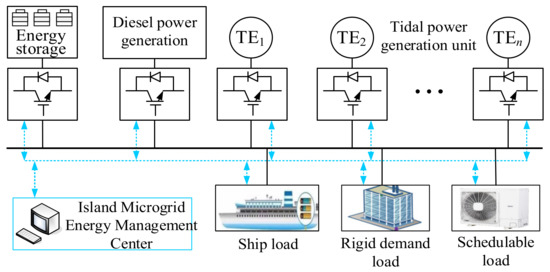
Figure 1.
Schematic diagram of an island microgrid power supply and distribution system.
This study examines an island microgrid comprised of tidal current energy generation units, diesel power generation units, energy storage units, rigid demand loads, and dispatchable loads with multiple time scales features, such as ships and air conditioners.
2.2. Maximum Power Tracking of Power Flow Power Generation
To ensure the efficient operation of the motor for the island microgrid, the tidal current energy generation units must control the motor to operate at the maximum power point during operation. By adjusting the velocity of the power flow generator, under varying seawater input flow rates, the power flow energy utilization coefficient is constantly maintained at its highest value, ensuring that the power of the power flow energy is the greatest, as shown in Figure 2.
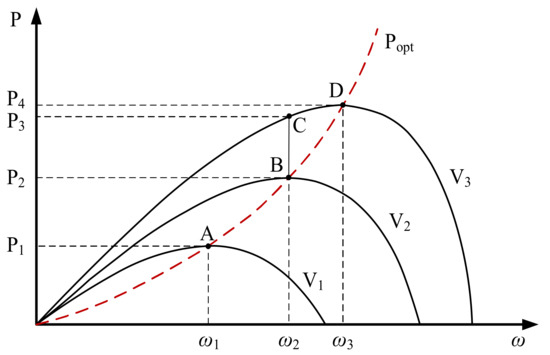
Figure 2.
Maximum power characteristic curve of a tidal current energy generation system.
The tidal current velocity as a function of time is:
where is the average tidal current velocity, is the periodic change frequency of the tidal current velocity, is the rising rate of the tidal current velocity when the spring tide comes, is the maximum value of the tidal current velocity increase during the spring tide, and is the noise of the tidal current velocity.
Under normal circumstances, the functional relationship between the power capture coefficient of the hydraulic impeller, the tip velocity ratio and the propeller angular pitch can be expressed as:
In the formula: the relationship between , and is:
The formula for calculating the output of the hydraulic impeller is:
where is the air density and is the area swept by the blade.
Due to the long-term operation of the generator system, the deterioration and aging of the hydraulic impeller tend to cause the reference signal of the control loop to change, resulting in issues such as decreased control precision and motor inefficiency. In order to facilitate the next multiple time scales coordinative dispatching and execution aimed at the maximum power tracking problem of the power flow power generation unit, this paper first proposes an MPPT intelligent control method for the power flow power generation unit based on the Q-Learning algorithm, as illustrated in Figure 3.
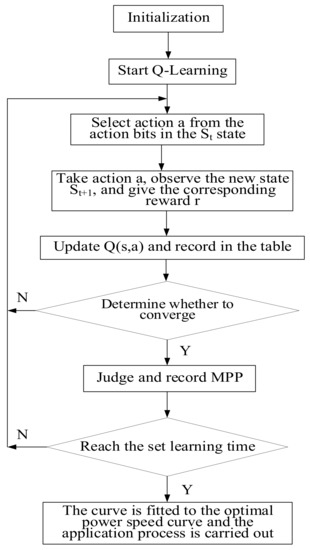
Figure 3.
Flow chart of MPPT intelligent control algorithm based on Q-Learning.
The Q-Learning algorithm is a reinforcement learning algorithm. Learning through reinforcement does not require an object model or prior knowledge. It can overlook difficulties such as system interference, time-varying, and nonlinearity throughout the learning process and seek the ideal solution by learning. This is its greatest benefit in solving the optimal control of huge complex systems.
When applying Q-Learning to MPPT control, we first define the three main terms, namely state space, action space, and reward.
- (1)
- State space
There exists an optimum value , and the turbine will extract the maximum power from the tidal current, namely:
In MPPT control, the pitch is usually kept constant and the total drag is controlled at its optimum value during water velocity changes. On the output characteristic curve of the hydraulic impeller, each wind velocity corresponds to an optimal rotor velocity. Thus, a rotor velocity-power pair can represent a state of the agent, a working point, based on which an action can be selected. The discretized state space is generated as follows:
where and are the number of equally divided line segments in the entire range of and , respectively.
The values of and have a significant impact on the learning outcomes and should be chosen with care: the greater the precision of their division, the longer the learning period, and the smaller the accuracy of their division, the less precise the learning outcomes. In the process of implementing a given control, three actions will be assigned to the action space, i.e., there will be three actions at each state point: rising, steady, and falling. The accuracy of the division will be governed by adjusting the change range of the action, such that the change in output power induced by each action change will correspond to the function value of a particular parameter.
- (2)
- Action space
The action space of the agent is expressed as:
where represents that the velocity changes, and 0 means that the velocity remains unchanged.
Control command update:
where and are the previous and current control commands, respectively.
In each state, the agent has three action options, namely “increment” (+), “decrement” (−), and “keep” (0), which is the aforementioned rise, unchanged, and fall. At each time step, the agent selects an action from the action space to modify the velocity control command based on the measurement of state and the action selection method used.
- (3)
- Rewards
After taking an action, the agent will be rewarded for evaluating the selected action. The Q-Learning reward mechanism in the MPPT control of tidal current energy generation is set as follows:
where and are the output powers of two consecutive time steps, and is a small positive number. If the selected action results in an increase in , a positive reward will be provided to the agent, otherwise, a negative reward will be provided to indicate punishment. However, measurement errors can cause small differences, even when the actual output power is the same for two consecutive time steps, or when the operating point is close to the maximum power point, it is difficult to detect the difference between and . So, we use a small positive number to set the bounds. When the absolute value of the difference between and is less than a sufficiently small , we can consider that the state point has reached the target state point.
As shown in Figure 4, it suggests that the power tracking situation of tidal current energy generation based on the Q-Learning algorithm.
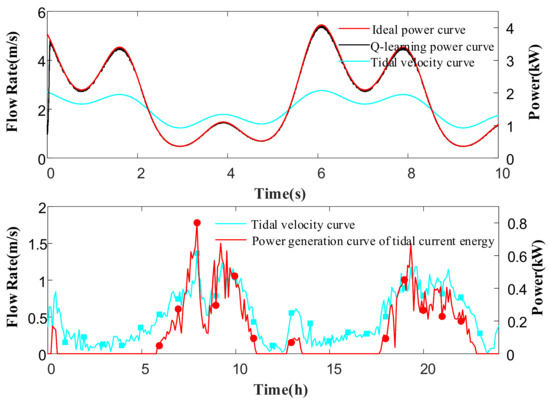
Figure 4.
Power tracking of tidal current energy generation based on Q-Learning algorithm.
3. Multiple Time Scales Rolling Coordinative Dispatching Method
3.1. Basic Architecture of Multiple Time Scales Rolling Coordinative Dispatching
This research first presents a multiple time scales rolling coordinative dispatching method for island microgrid with a large share of tidal current energy access that considers demand response resources in order to schedule diverse resources at multiple time scales on the island. The fundamental structure is depicted in Figure 5. (1) Optimized dispatching layer: It is implemented by the energy management system (EMS) of the island microgrid using a 1-day time scale. EMS realizes the operation optimization and dispatching of the independent microgrid on a global scale using a global optimization algorithm and provides the planning curve for the island microgrid central controller (MGCC); (2) Coordination control layer: based on a 15-min time scale and implemented by MGCC. Through the “source-load-storage” multi-energy complementary coordinated control method based on logic judgment, the deviation between the actual working condition and the ideal working condition is corrected, and control commands are sent to the island microgrid’s local controller to implement multi-energy complementary coordinated control. (3) Real-time control layer: based on a 5-min time scale and implemented by commanding the local controller. Locally distributed generation/load/storage executes command execution.
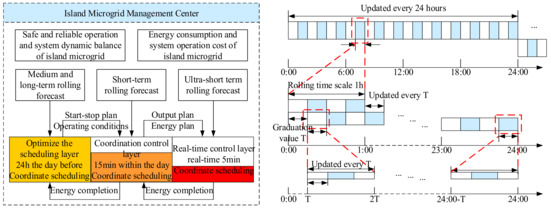
Figure 5.
Multiple time scales rolling coordinative dispatching method for island microgrid.
On the basis of verifying the validity of the day-ahead dispatch plan, intraday rolling optimization of the island microgrid dispatch plan can limit the influence of the day-ahead forecast inaccuracy on the intraday dispatch results. multi-scale rolling coordinative dispatching is successively recursively coordinated at equal time intervals. The day-ahead dispatching plan is produced every 24 h, while the intraday dispatching plan and real-time dispatching plan are formulated every 15 min and 5 min, respectively. The time period corresponding to the intraday and real-time dispatching plan advances as time passes. The optimization of each time scale is based on the optimization results of the preceding time scale, and the appropriate optimization solutions are implemented based on the optimization objectives and control variables of each time scale.
- (1)
- Day-ahead dispatch plan: according to the medium and long-term forecast data of tidal current energy generation, load power, etc., considering the tidal current energy consumption of the island microgrid and the total carbon of the system emissions, we get the 24-h day-ahead operation plan of each equipment, and arrange the start-stop plan and dispatchable load operation conditions;
- (2)
- Intraday dispatch plan: take 15 min as a period and 1 h as a cycle (4 periods in total), on the basis of the previous dispatch plan and the short-term forecast data of tidal current energy generation, load power, etc., we modify the output of equipment and dispatchable load every 15 min;
- (3)
- Real-time dispatch plan: take 5 min as a period and 15 min as a cycle (3 periods in total), change the equipment output and dispatchable load based on the ultra-short-term forecast data of tidal current energy generation, load power, etc.
3.2. Multiple Time Scales Rolling Coordinative Dispatching Implementation Process
This paper considers the load resources in an island microgrid with flexible working hours without significantly affecting the utility as the dispatching object, responding to the island microgrid through the interactive response of the island source and load on multiple time scales to address the challenges posed by the high proportion of tidal current energy generation connected to the island microgrid in order to achieve the objective of optimal allocation of island resources. Figure 6 illustrates the deployment process of the island microgrid’s multiple time scales rolling coordinative dispatching.
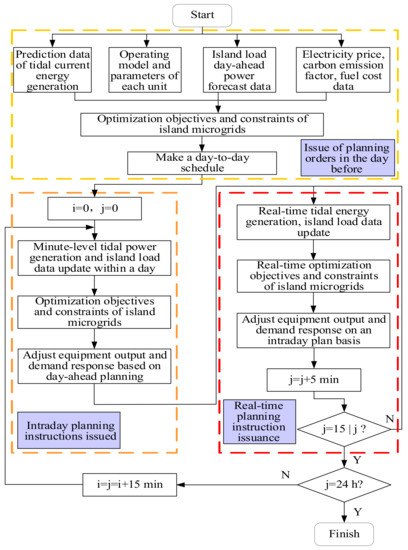
Figure 6.
Implementation process of island microgrid multiple time scales rolling coordinative dispatching.
Island source-load response dispatching requires two dimensions of problem resolution:
- (1)
- Time dimension: It is important to accommodate variances in the prediction error of the island source and load over multiple time scales, the scope of adjustment resources, and their associated costs;
- (2)
- Object dimension: When engaging in the dispatching operation of island microgrid, it is required to accommodate demand response projects of diverse natures and loads with varying characteristics.
The dispatchable loads of the island microgrid comprise not only typical loads such as lighting, air conditioners, refrigerators, etc., from the residential loads of island residents, but also bidirectionally controllable loads such as energy storage and ships. Different loads have varying reaction and adjustment capabilities, as well as adaptability to system unpredictability. In contrast, during the optimization of the island’s operation, these demand-side resources can respond to the dispatching demand in real time and contribute to the equilibrium between supply and demand.
3.3. Multiple Time Scales Rolling Coordinative Dispatching Model
According to the response velocity and action characteristics of the various sources and loads in the island microgrid, the equipment with a slow response velocity and a small number of actions, such as diesel power generation units, energy storage units, ship loads, etc., are used as long-term source-load for dispatching on the basis of determining the fundamental architecture and implementation process of the multiple time scales rolling coordinative dispatching of the island microgrid. The day-ahead functioning of the system, the reduction of intraday carbon emissions, and the stability of the system in real-time are all economically optimized. This leads to the establishment of a multiple time scales day-ahead-intraday-real-time rolling coordinative dispatching model.
3.3.1. Day-Ahead Dispatching Model
The optimal adjustment scheme for each hour of the slow-motion equipment in the next 24 h is optimized and solved using the predicted tidal current energy generation power and island load data as input variables, and the start and stop actions of diesel power generation units and energy storage units as control variables.
- (1)
- Objective function
The target function is to minimize the sum of the power generating cost of the diesel power generation unit, start-stop penalty fee, and power curtailment penalty cost:
where is the number of time periods in the dispatching plan; is the number of diesel power generation units; is the number of energy storage units; is the number of power flow energy generation units; is the weight coefficient of the sub-target; is the start and stop state of the diesel power generation unit and the energy storage unit in the period (starting up is 1, and shutting down is 0); is the planned output of diesel power generation unit and energy storage unit in period , respectively; and are the power generation cost and start-up cost of diesel power generation unit in period , respectively, and the start-stop cost is considered in the objective function (it is preferred to avoid frequent equipment start and stop); is the tidal current energy penalty factor of the tidal current energy generation unit . In order to maximize the consumption of the tidal current energy, should be set to a larger value; is the abandoned tidal current energy of the tidal current energy generating unit in the period .
- (2)
- Constraints
- 1.
- Constraints of tidal current energy generation unitThe output power of the tidal current energy generation unit should meet:where and are the minimum and maximum output power of the tidal current energy generation unit, respectively.
- 2.
- Diesel generator unit constraintsThe output power of the diesel generator unit should meet:where and are the minimum and maximum output power of the diesel generating unit, respectively.
- 3.
- Energy storage unit constraints
Assuming that the maximum charging power of the energy storage unit is equal to the maximum discharging power, then during the charging and discharging process, the following conditions are satisfied:
where and represent the upper and lower limits of the charge and discharge power of the energy storage unit.
The energy storage unit cannot exceed the capacity available for energy storage, namely:
where and represent the upper and lower capacity limits of the energy storage unit.
It is assumed that the state of charge at the beginning of charging is 90%, the state of charge at the end of charging is 10%, and the state of charge at the end of discharge is equal to the state of charge at the beginning of charging.
where and are the state of charge of the battery energy storage at time and time , respectively; and are the charging efficiency and discharging efficiency of the battery energy storage, respectively; is a 0–1 function representing the charging/discharging of the energy storage—1 when charging and 0 when discharging.
3.3.2. Intraday Dispatching Model
To avoid frequent activation of diesel power production units and energy storage units, the intraday dispatch plan must carefully adhere to the day-ahead dispatch plan.
- (1)
- Objective function
Using as the aim function the least dispatch cost and carbon emission of the island microgrid demand response resources, we get:
where is the number of time periods scheduled in the previous day; is the dispatch cost of dispatchable load resource in time period ; is the dispatched power of dispatchable load resource in time period ; is the carbon emission factor of diesel power generation units.
- (2)
- Constraints
- 1.
- Demand response resource constraintsThe schedulable power of a demand response resource should satisfy:where and are the minimum and maximum schedulable load powers of the demand response resources, respectively.
- 2.
- Carbon emission constraint equationThe carbon emissions of all load distributions in the island microgrid are equal to the carbon emissions generated by the diesel generating units.where is the carbon emission factor of the just-demanded load; is the carbon emission factor of the dispatchable load.
3.3.3. Real-Time Dispatching Model
In the real-time adjustment phase, it is primarily necessary to fine-tune the intraday dispatch plan to meet the changing requirements of the island microgrid’s actual operation.
- (1)
- Objective function
Using the minimum island microgrid power fluctuation as the objective function:
where is the net load at time ; is the average value of the net load at time .
The net load and the mean net load are expressed as:
- (2)
- Constraints
Island microgrid power balance constraints:
where is the number of the just-needed loads; is the number of the dispatchable loads; is the load power of the just-needed loads; is the load power of the dispatchable load .
4. Results and Discussions
The island microgrid structure depicted in Figure 1 serves as the target of analysis in this paper. In the calculation example, the island microgrid is assumed to consist of a 100 kW tidal current energy generator, a 60 kW diesel generator, and a 100 kWh storage battery with a maximum charge and discharge power of 50 kW, as well as a rigid demand load that does not participate in the demand side response, the 40 kW ship load that does participate in demand side response, and the 20 kW controllable load.
A whole schedule period for the calculation example is 0:00–24:00, or 24 h in total. The dispatching time interval of the intraday rolling optimization stage is 15 min, or 96 rolling optimizations per day. The dispatching time period of the real-time dispatching stage is 5 min, or three dynamic adjustments to each rolling interval. The objective optimization phase may employ optimization algorithms such as genetics and particle swarms, whereas the prediction phase may include prediction methods such as neural networks. This research concentrates on the efficacy of the dispatching method, hence optimization and prediction methods are omitted.
4.1. Day-Ahead Dispatching Result Analysis
The tidal current energy generation and island load curve used in the pre-stage simulation are shown in Figure 7.
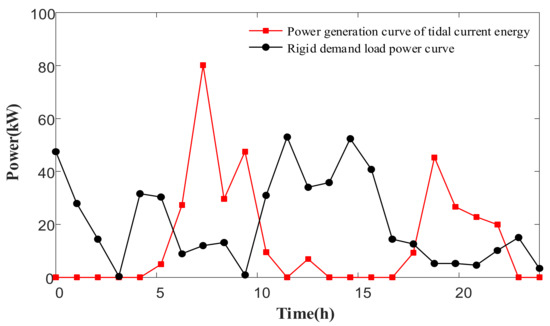
Figure 7.
A 24-h curve of the day-ahead tidal current energy generation output and island load.
In the day-ahead dispatching stage, equipment with slow response velocity and a limited number of actions is used as a long-term schedule-controllable resource, and the optimal adjustment scheme for diesel power generation, energy storage, and ship load in each hour of the following 24 h is optimized and solved. The ideal dispatching outcomes are depicted in Figure 8.
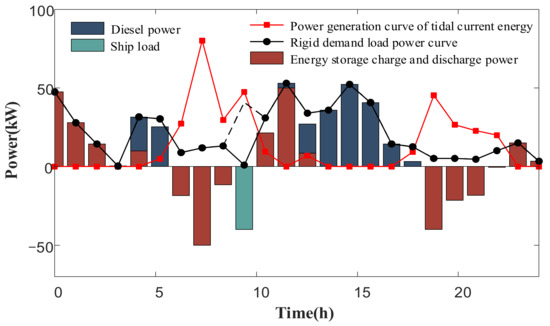
Figure 8.
The results of the day-ahead dispatching.
Figure 8 demonstrates that, in this case, under the tidal current capacity output and load fluctuations, the tidal current capacity output during the hours of 7:00–10:00 and 19:00–22:00 is more than the island load power during the long-term optimization. The aim function of daily dispatching is the minimization of the sum of diesel power generating cost, start-stop penalty fee, and tidal current energy penalty cost. Therefore, the energy storage is charged during periods of high tidal current energy output and drained during periods of high load power. During the peak of tidal current energy output, it will be challenging for the energy storage to retain sufficient capacity to absorb the tidal current energy. After the SOC hits its peak, the energy storage will be connected at 10:00 through ship load, thereby decreasing the island’s energy usage. The energy from the tidal current is disregarded, and the ship load is connected during the load trough period, which has a pronounced effect on peak shaving and valley filling. The energy consumption rate of power flow has been improved by 14.11% through day-ahead dispatching.
4.2. Analysis of Intraday Dispatching Results
The tidal current energy generation and island load curves used in intraday simulation are shown in Figure 9.
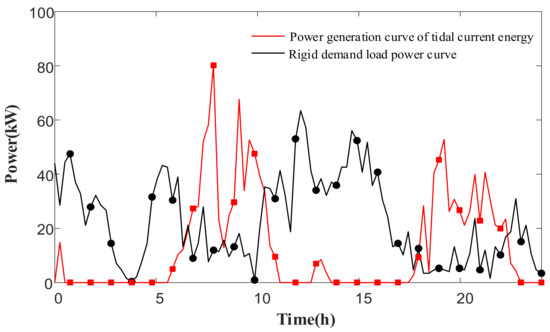
Figure 9.
A 24-h curve of intraday tidal current energy generation output and island load.
In the intraday dispatching phase, the day-ahead dispatching plan is closely adhered to in order to prevent the frequent startup of diesel power generation and energy storage units. Rolling optimization yields the optimal output plan for diesel power generation, energy storage, and ship load every 15 min. The optimal dispatching outcomes are illustrated in Figure 10.
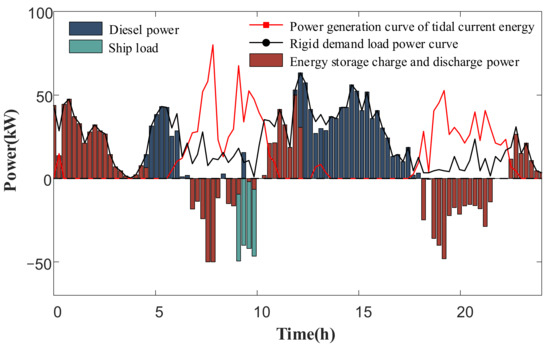
Figure 10.
The results of the intraday dispatching.
As shown in Figure 10, the intraday rolling optimization dispatch compensates for the fluctuations in the tidal current energy generation output and the intraday forecast of island load by adjusting the intraday operating power of energy storage and diesel power generation based on the day-ahead dispatch plan. On the basis of verifying the validity of the day-ahead dispatching plan, the influence of the day-ahead forecast mistake on the intraday dispatching results is minimized. Since intraday dispatch uses the dispatch cost of island microgrid demand response resources and the minimum carbon emission as the objective function, the power adjustment amount of ship load on a long-term scale within 15 min per day is also small, which satisfies the economic requirements; energy storage and diesel power generation. The output adheres to the prior schedule, thereby avoiding frequent actions.
4.3. Analysis of Real-Time Dispatching Results
The tidal current energy generation and the island load curve used in the real-time simulation are shown in Figure 11.
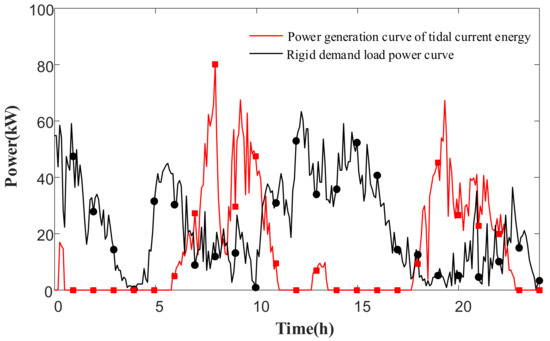
Figure 11.
A 24-h curve of real-time tidal current energy generation output and island load.
In the real-time dispatching phase, devices with a quick response time and an unlimited number of actions are utilized to schedule source-load on medium and short time scales. The optimal dispatching result is depicted in Figure 8; the rolling optimization solves the optimal adjustment scheme for the schedulable load every 5 min.
As shown in Figure 12, it demonstrates that real-time dispatch is mostly used to fine-tune the intraday dispatch plan. The target function is to minimize the island microgrid’s power fluctuations. After considering the role of the dispatchable load on the time scale, the dispatchable load agent performs a portion of the power adjustment. Through intraday dispatching and real-time dispatching, the energy consumption rate of power flow has been improved by 2.97%. It significantly reduces the system’s need for energy and diesel power production reserve capacity, improves the system’s economics, and satisfies the real operating requirements of the island microgrid.
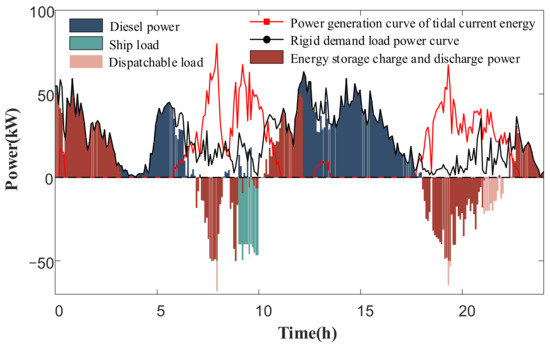
Figure 12.
The results of the real-time dispatching.
5. Conclusions and Prospects
In the coming decades, it is anticipated that tidal current energy generation will become an essential source of electricity for the clean, sustainable, and economical power supply of islands. This paper proposes a multiple time scales rolling coordinative dispatching method for an island microgrid with a high proportion of tidal current energy access and demand response resources; MPPT control based on Q-Learning algorithm is proposed to perform real-time maximum power tracking of tidal current energy generation; a multiple time scales day-ahead, intraday, and real-time rolling coordinative dispatching model for an island microgrid is established. Finally, example analysis verifies the validity and advancement of the dispatching method.
The following is a summary of this paper’s principal findings:
- (1)
- The interplay between ship traffic and energy on long time scales and the balance between supply and demand on short time scales can be achieved by considering the multiple time scales characteristics of island demand response resources;
- (2)
- Participating in the coordinative dispatching of an island microgrid via demand response resources will increase the system’s dynamic power balance capability and its capacity to absorb renewable energy, as well as lessen the operating pressure of diesel power generation and energy storage;
- (3)
- The MPPT intelligent control method of power flow energy generation based on the Q-Learning algorithm can keep the power flow energy utilization at the maximum value and ensure the maximum power of the power flow energy captured. It is convenient for the next multi-time scale coordination scheduling to be executed more efficiently;
- (4)
- The multiple time scales day-ahead, intraday, and real-time rolling coordinative dispatching method of an island microgrid can make full use of tidal current energy and reduce the use of island diesel power generation, which is of critical importance to the sustainable development of an island;
In the following stage, we intend to perform additional study on an island microgrid that can be linked to a significant proportion of tidal currents. Using a multiple time scales rolling coordinative dispatching method for an island microgrid that takes into account demand response resources, this paper aims to solve the dispatching and safe and stable operation of a high proportion of tidal current energy connected to the island in an effort to promote future large-scale use of tidal current energy generation.
Author Contributions
Y.O. conceived and designed the study; W.Z., H.W. and W.W. have given suggestions and revised the manuscript. All authors have read and agreed to the published version of the manuscript.
Funding
Strategic Priority Research Program of the Chinese Academy of Sciences (XDA22010401), National Natural Science Foundation of China (51877204) and the Institude of Electrical Engineering, CAS (1551502).
Conflicts of Interest
The authors declare no conflict of interest.
References
- Ermakov, A.; Marie, A.; Ringwood, J.V. Some Fundamental Results for Cyclorotor Wave Energy Converters for Optimum Power Capture. IEEE Trans. Sustain. Energy 2022, 13, 1869–1872. [Google Scholar] [CrossRef]
- Rasool, S.; Muttaqi, K.M.; Sutanto, D. A Multi-Filter Based Dynamic Power Sharing Control for a Hybrid Energy Storage System Integrated to a Wave Energy Converter for Output Power Smoothing. IEEE Trans. Sustain. Energy 2022, 13, 1693–1706. [Google Scholar] [CrossRef]
- Lu, Q.; Shi, H. Progress and Future Trend of Ware Energy Technology in China. Coast. Eng. 2022, 41, 1–12. [Google Scholar]
- Kai, L.Y.; Sarip, S.; Kaidi, H.M.; Ardila-Rey, J.A.; Samsuddin, N.M.; Muhtazaruddin, M.N.; Muhammad-Sukki, F.; Aziz, S.A. Current Status and Possible Future Applications of Marine Current Energy Devices in Malaysia: A Review. IEEE Access 2021, 9, 86869–86888. [Google Scholar] [CrossRef]
- Zhang, Z.; Kang, C. Challenges and Prospects for Constructing the New-type Power System Towards a Carbon Neutrality Future. Proc. CSEE 2022, 42, 2806–2819. [Google Scholar]
- Zhuo, Z.; Du, E.; Zhang, N.; Nielsen, C.P.; Lu, X.; Xiao, J.; Wu, J.; Kang, C. Cost increase in the electricity supply to achieve carbon neutrality in China. Nat. Commun. 2022, 13, 3172. [Google Scholar] [CrossRef]
- Zhang, Y.; Li, G. Non-Causal Linear Optimal Control of Wave Energy Converters With Enhanced Robustness by Sliding Mode Control. IEEE Trans. Sustain. Energy 2020, 11, 2201–2209. [Google Scholar] [CrossRef]
- Haider, A.S.; Brekken, T.K.A.; Coe, R.G.; Bacelli, G.; McCall, A. On Real-Time Hybrid Testing of Ocean Wave Energy Conversion Systems: An Experimental Study. IEEE Open J. Ind. Appl. 2022, 3, 30–40. [Google Scholar] [CrossRef]
- Meng, F.; Ding, B.; Sergiienko, N.Y.; Chen, H.; Xu, H.; Li, Y. Power Set-Point Tracking of a Wave Energy Converter With Multiple Power Take-Off Units in Irregular Waves. IEEE Trans. Sustain. Energy 2022, 13, 767–777. [Google Scholar] [CrossRef]
- Song, M.; Sun, W.; Shahidehpour, M.; Yan, M.; Gao, C. Multi-Time Scale Coordinated Control and Scheduling of Inverter-Based TCLs With Variable Wind Generation. IEEE Trans. Sustain. Energy 2021, 12, 46–57. [Google Scholar] [CrossRef]
- Xu, J.; Liao, S.; Jiang, H.; Zhang, D.; Sun, Y.; Ke, D.; Li, X.; Yang, J.; Peng, X.; Yao, L. A multi-time scale tie-line energy and reserve allocation model considering wind power uncertainties for multi-area systems. CSEE J. Power Energy Syst. 2021, 7, 677–687. [Google Scholar] [CrossRef]
- Yi, Z.; Xu, Y.; Gu, W.; Wu, W. A Multi-Time-Scale Economic Scheduling Strategy for Virtual Power Plant Based on Deferrable Loads Aggregation and Disaggregation. IEEE Trans. Sustain. Energy 2020, 11, 1332–1346. [Google Scholar] [CrossRef]
- Hu, J.; Zhou, H.; Li, Y.; Hou, P.; Yang, G. Multi-time Scale Energy Management Strategy of Aggregator Characterized by Photovoltaic Generation and Electric Vehicles. J. Mod. Power Syst. Clean Energy 2020, 8, 727–736. [Google Scholar] [CrossRef]
- Xing, X.; Xie, L.; Meng, H.; Guo, X.; Yue, L.; Guerrero, J.M. Energy management strategy considering multi-time-scale operational modes of batteries for the grid-connected microgrids community. CSEE J. Power Energy Syst. 2020, 6, 111–121. [Google Scholar] [CrossRef]
- Liu, J.; Huang, X.; Li, Z. Multi-time Scale Optimal Power Flow Strategy for Medium-voltage DC Power Grid Considering Different Operation Modes. J. Mod. Power Syst. Clean Energy 2020, 8, 46–54. [Google Scholar] [CrossRef]
- Wang, L.; Zhou, J.; Zhu, L.; Wang, X.; Yin, C.; Cong, H. Multi-time-scale Optimization Scheduling of Integrated Energy System Based on Distributed Model Predictive Control. Autom. Electr. Power Syst. 2021, 45, 57–65. [Google Scholar]
- Zhang, J.; Qin, D.; Ye, Y.; He, Y.; Fu, X.; Yang, J.; Shi, G.; Zhang, H. Multi-Time Scale Economic Scheduling Method Based on Day-Ahead Robust Optimization and Intraday MPC Rolling Optimization for Microgrid. IEEE Access 2021, 9, 140315–140324. [Google Scholar] [CrossRef]
- Masrur, H.; Gamil, M.M.; Islam, M.R.; Muttaqi, K.M.; Lipu, M.S.H.; Senjyu, T. An Optimized and Outage-Resilient Energy Management Framework for Multicarrier Energy Microgrids Integrating Demand Response. IEEE Trans. Ind. Appl. 2022, 58, 4171–4180. [Google Scholar] [CrossRef]
- Huang, C.; Zhang, H.; Song, Y.; Wang, L.; Ahmad, T.; Luo, X. Demand Response for Industrial Micro-Grid Considering Photovoltaic Power Uncertainty and Battery Operational Cost. IEEE Trans. Smart Grid 2021, 12, 3043–3055. [Google Scholar] [CrossRef]
- Waseem, M.; Lin, Z.; Ding, Y.; Wen, F.; Liu, S.; Palu, I. Technologies and Practical Implementations of Air-conditioner Based Demand Response. J. Mod. Power Syst. Clean Energy 2021, 9, 1395–1413. [Google Scholar] [CrossRef]
- Algarni, A.S.; Suryanarayanan, S.; Siegel, H.J.; Maciejewski, A.A. Combined Impact of Demand Response Aggregators and Carbon Taxation on Emissions Reduction in Electric Power Systems. IEEE Trans. Smart Grid 2021, 12, 1825–1827. [Google Scholar] [CrossRef]
- Gao, J.; Ma, Z.; Yang, Y.; Gao, F.; Guo, G.; Lang, Y. The Impact of Customers’ Demand Response Behaviors on Power System With Renewable Energy Sources. IEEE Trans. Sustain. Energy 2020, 11, 2581–2592. [Google Scholar] [CrossRef]
- Zhang, Z.; Huang, Y.; Chen, H.; Huang, Q.; Lee, W.-J. A Novel Hierarchical Demand Response Strategy for Residential Microgrid. IEEE Trans. Ind. Appl. 2021, 57, 3262–3271. [Google Scholar] [CrossRef]
Publisher’s Note: MDPI stays neutral with regard to jurisdictional claims in published maps and institutional affiliations. |
© 2022 by the authors. Licensee MDPI, Basel, Switzerland. This article is an open access article distributed under the terms and conditions of the Creative Commons Attribution (CC BY) license (https://creativecommons.org/licenses/by/4.0/).